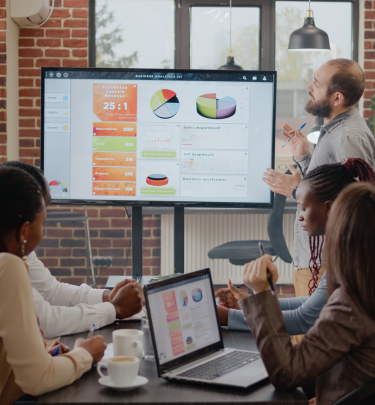This website uses cookies so that we can provide you with the best user experience possible. Cookie information is stored in your browser and performs functions such as recognising you when you return to our website and helping our team to understand which sections of the website you find most interesting and useful.
May 08, 2024
Integrating technology in the workplace to improve wellbeing, productivity, and work experience was the main talking point during Williams Lea’s latest Legal Operations and Administration Forum (LOAF), co-hosted by Pathogen Reduction Solutions (PRS). Chris Bull from Edge International chaired the London session featuring experts in workplace tech innovation Ann-Marie Aguilar, Senior Vice President of the International WELL Building Institute; William Wood, Technical Account Director at Marlin Communications; and Ian Sinclair, CEO of PRS. The session provided the audience with valuable insights on technology’s role in transforming the office and the importance of creating sustainable and healthy buildings. Here are the top three takeaways from the event:
Indoor air quality is key to health and productivity
According to a recent study published by the UK Parliament, people spend approximately 80-90% of their time indoors, making the air they breathe at work very important to their well-being[1]. The effects of poor indoor air quality on health are less well understood than those due to poor outdoor air quality. Poor indoor air quality has been shown to negatively impact employee health, causing issues such as sick building syndrome which may include headaches and fatigue. When staff are unwell, it leads to higher absenteeism and lower productivity. The COVID-19 pandemic brought greater attention to this topic, as indoor spaces were recognized as high-risk areas for virus transmission.
There are steps workplaces can take to enhance indoor air quality. Ian Sinclair demonstrated how integrating advanced air filtration systems like those from PRS can remove up to 97% of airborne pathogens and pollutants like VOCs (volatile organic compounds). Proper ventilation and monitoring of CO2 levels is also important to dilute contaminants and ensure adequate fresh air circulation. Ann-Marie Aguilar emphasized the value of employing the WELL Building Standard to provide a framework for evaluating factors like ventilation, filtration, and using materials low in VOCs, which negatively affect air quality, and can be up to ten times higher indoors than outdoors. Following these best practices can create a healthier internal environment where employees are more comfortable and better able to perform at their best.
New technologies play a vital role in improving the workplace and employee experience
Marlin Communications’ William Wood discussed the importance of integrating technology into the workplace to improve the employee experience. He highlighted that to navigate the challenges of hybrid work, law firms must prioritize a seamless employee experience. This includes minimizing the need for multiple apps and platforms employees use. Digital signage and workspace technologies are crucial, improving communication and reducing onboard friction for employees. Modern meeting room layouts must be flexible to suit varied needs, while the latest meeting technologies can automate notetaking, summarize discussions, and pinpoint action items. AI-powered notetaking offers huge benefits, saving employees valuable time and improving meeting effectiveness. Ultimately, by minimizing technological barriers, companies will empower their workforce, increase efficiency, optimize office space usage, and ultimately see a greater return on their investments.
Wood also pointed out that there’s a significant shift toward technology used for meeting rooms and similar facilities. Traditionally, building a single solution for such rooms involved multiple vendors, which resulted in complexity and higher costs. “There might be five different vendors involved in delivering one solution for a meeting room,” said Wood. “You can have a vendor for the for the air conditioning control, you might have Cisco for the video systems in the room. You might have Sennheiser mics in the ceiling, and Yamaha speakers, and a Crestron system as a room controller to do things like raise and lower blinds.” However, the recent trend is that a single vendor can now deliver the entire solution. This leads to a reduction in cost, simplified support processes, and an improved user experience, as the system can seamlessly adjust to changes in room configurations.
Establishing a proven development framework will foster diversity, and attract talent
Along with creating a healthy workplace environment, Diversity, Equality, and Inclusion (DE&I) have become fundamental aspects of successful workplaces, especially among law firms, where it remains top of the agenda. Ann-Marie Aguilar pointed out some key statistics in the recruitment imperative: 76% of job candidates seek out diverse companies[2], which are 2.9 times more likely to identify and build leaders[3]. Gen Z also values DE&I more than prior generations, according to Fortune magazine[4].
Law firms are increasingly recognizing the importance of creating environments where employees from all backgrounds feel valued, respected, and empowered to contribute their unique perspectives. This shift goes beyond simply checking a box – it’s about harnessing the collective talent of a diverse workforce to drive innovation, improve employee well-being, and ultimately, achieve business success.
Aguilar emphasized the importance of establishing development goals to encourage greater diversity and inclusion, including creating a third-party verified solution that uplifts those historically excluded voices, helps organizations make good on their commitments and report their progress to stakeholders. The WELL Standard provides a framework to help law firms drive a commitment to employee well-being and DE&I initiatives. “If your company is really looking to prioritize diversity, equity, and inclusivity, you can actually focus on features at WELL that drive that conversation,” said Aguilar. She also went to say, “this an important imperative for most of our clients, and if you want to retain the best talent you need to be seeking out a diverse workforce. And many of our clients (including law firms) are looking at ESG performance and the environments that will allow for equity inclusivity and diversity.”
Williams Lea has partnered with Unwork to create a report that explores cutting-edge technologies like hoteling software, space utilization tools, and AI, and provides insights to help firms make informed investments in workplace technology. Download the report today.
[1] Duffield, Bunn; The Parliamentary Office of Science and Technology (POST), Indoor Air Quality, 26 September 2023: https://researchbriefings.files.parliament.uk/documents/POST-PB-0054/POST-PB-0054.pdf
[2][2] Glassdoor, Really think about your diversity and inclusion stats, July 2021: https://www.glassdoor.com/employers/blog/diversity/
[3] Bersin, Why diversity and inclusion has become a business priority, March 2019: https://joshbersin.com/2015/12/why-diversity-and-inclusion-will-be-a-top-priority-for-2016/
[4] Chow, Diversity is not ‘a journey.’ Here’s why soft language in DEI may actually make it more difficult to achieve hard results, June 2022: https://fortune.com/2022/06/22/diversity-dei-journey-language-results-success-careers-anne-chow/
Share
Insights
Case studies
Driving client growth and success through highly skilled business-critical support services

















